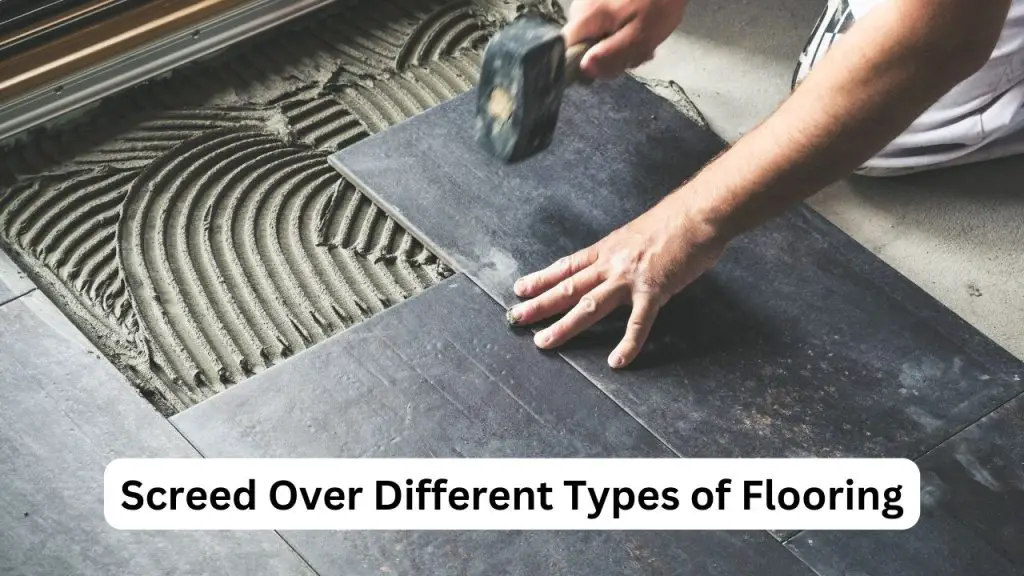Screeding is a technique that involves applying a layer of screed mixture, typically consisting of cement, sand, and water, to create a smooth and level surface. It is commonly used before installing different types of flooring, such as tiles, laminate, or vinyl, to ensure a stable and even base. However, the compatibility of screeding with various flooring materials may vary. Let’s explore the answers to your specific questions.

Can You Screed Over Asbestos Tiles?
No, it is not recommended to screed over asbestos tiles. Asbestos is a hazardous material, and disturbing it can release harmful fibers into the air. It is crucial to follow proper asbestos removal procedures by consulting with professionals trained in asbestos handling and disposal.
Can You Screed Over Asphalt Floor?
Screeding over an asphalt floor is generally not recommended. Asphalt is a flexible material, and screeding requires a rigid and stable surface. The movement and flexibility of asphalt can compromise the integrity of the screed layer, leading to cracking or other structural issues.
Can You Screed Over Bitumen Floor?
Yes, you can screed over a bitumen floor. Bitumen is a durable and stable material, providing a suitable base for screeding. However, it is important to ensure that the bitumen surface is clean, free from any contaminants, and well-prepared before applying the screed layer.
Can You Screed Over Ceramic Tiles?
In most cases, it is not recommended to screed directly over ceramic tiles. Screeding requires a roughened or absorbent surface to create a strong bond. Ceramic tiles typically have a smooth and non-absorbent finish, making it challenging for the screed to adhere properly. It is advisable to remove the ceramic tiles before applying the screed layer.
Can You Screed Over Chipboard?
Screeding over chipboard is generally not recommended. Chipboard is a type of engineered wood that can be prone to swelling or warping when exposed to moisture. Screeding involves the use of a wet mixture, which can cause the chipboard to deteriorate or become unstable. It is best to use a different method for leveling chipboard floors.
Can You Screed Over Concrete?
Yes, you can screed over concrete. Concrete provides an excellent surface for screeding, as it is already solid, stable, and durable. However, it is crucial to ensure that the concrete is clean, free from any contaminants, and properly cured before applying the screed layer.
Can You Screed Over Electric Underfloor Heating?
Yes, it is possible to screed over electric underfloor heating systems. However, it is important to follow the manufacturer’s guidelines and ensure that the screed layer does not exceed the maximum allowed thickness. Additionally, proper insulation and compatibility between the screed and the heating system should be considered to avoid any heat transfer issues.
Can You Screed Over Floor Tiles?
Screeding directly over floor tiles is generally not recommended. Similar to ceramic tiles, floor tiles typically have a smooth and non-absorbent surface, making it difficult for the screed to adhere properly. It is advisable to remove the floor tiles before applying the screed layer.
Can You Screed Over Marley Tiles?
Screeding over Marley tiles is not recommended. Marley tiles are often made of vinyl or rubber and have a flexible nature. The flexibility of Marley tiles can lead to movement and potential issues with the screed layer, such as cracking or disbondment. It is advisable to remove Marley tiles before screeding.
Can You Screed Over Parquet Flooring?
In most cases, screeding over parquet flooring is not recommended. Parquet flooring consists of individual wood pieces that are laid in a specific pattern. Screeding directly over parquet can hide the natural beauty of the flooring and may not provide the desired results. It is best to consult with flooring specialists to explore alternative options for leveling parquet floors.
Can You Screed Over Plywood?
Screeding over plywood is generally not recommended. Plywood is a type of engineered wood that can be prone to warping or swelling when exposed to moisture. The wet screed mixture can compromise the stability and integrity of the plywood, leading to structural issues. Alternative methods should be considered for leveling plywood surfaces.
Can You Screed Over Underfloor Heating?
Yes, it is possible to screed over underfloor heating systems. However, it is crucial to ensure that the screed layer is compatible with the heating system and does not exceed the maximum allowed thickness. Proper insulation and heat transfer considerations should be taken into account to optimize the performance of the underfloor heating.
Can You Screed Over Vinyl Tiles?
Screeding over vinyl tiles is generally not recommended. Vinyl tiles have a smooth and non-absorbent surface, making it challenging for the screed to adhere properly. Moreover, the flexibility of vinyl tiles can cause movement and potential issues with the screed layer. It is advisable to remove the vinyl tiles before applying the screed.
Can You Screed Over Wood?
Screeding directly over wood is not recommended. Wood is a natural material that can expand or contract with changes in moisture levels. The wet screed mixture can cause the wood to warp, leading to structural issues. It is advisable to explore alternative methods for leveling wooden surfaces, such as using self-leveling compounds.
Can you screed over chipboard?
Screeding over chipboard is generally not recommended. Chipboard is a type of engineered wood that can be prone to swelling or warping when exposed to moisture. Screeding involves the use of a wet mixture, which can cause the chipboard to deteriorate or become unstable. It is best to use a different method for leveling chipboard floors.
Conclusion
In conclusion, screeding can be performed on various flooring materials, but it is essential to consider the compatibility and specific requirements of each type. While some materials like concrete and bitumen are suitable for screeding, others such as ceramic tiles, chipboard, or wood may not provide optimal results. Always consult with flooring specialists or professionals to determine the best approach for your specific flooring project.
